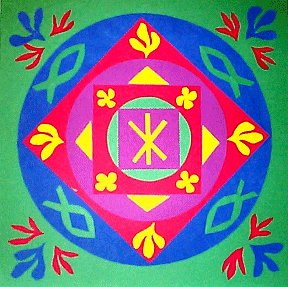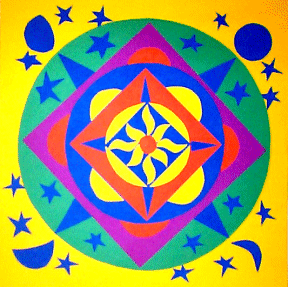

|
|
|
|||
|
|
|
Collage
Method for the Symbolic
Embellishment
of Seven-Level Mandalas
| The four shapes below are as essential to creative design as the four elements they graphically represent: circle (air); square (earth); triangle (fire); and crescent (water). | ||
|
|
||
| These shapes are easily cut from 1" strips of paper. For squares make 1" vertical cuts; for circles round off the corners of squares; for triangles make diagonal cuts; for crescents cut as below from 1" by 1 1/2" rectangles. | ||
|
|
||
|
By cutting wider or narrower strips you can make smaller or larger shapes which in turn may be combined, grouped, varied, rotated, and superimposed on assembled mandalas wherever space and inspiration dictate. |
||
|
|
||
|
Circles, squares and triangles cut on the fold from 2" squares (as shown below) may be interlaced and used as "centering" symbols. |
||
|
|
||
| In addition to circle, square, triangle and crescent, three other shapes--the rectangle, the "s" curve and the spiral--are components of many familiar symbols. | ||
|
|
||
|
The "S" curve is most easily cut from a rectangle, and a spiral from a square. Variations of leaves, as demonstrated by the collages of Matisse, also emerge from rectangles and squares: |
||
|
|
||
|
Altogether the seven shapes below--each an archetype in its own right--provide the means by which anyone--young or old, right-brained or left-brained, experienced artist or novice--can begin to experience and express his or her creative self. |
||
|
|
||
|
Experiment to make flowers, suns, signs of the Zodiac, crosses and geometric motifs: |
||
|
|
||
|
Below are examples showing how simple it is to individualize a mandala, and proving Cirlot's statement (A Dictionary of Symbols) that a mandala is
This also makes clear why creating mandalas is calming, centering and psychologically and spiritually restoring as the energies of square (earth) and circle (heaven) are engaged in a rhythmically balancing interchange. |
||
|
|
||